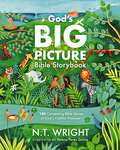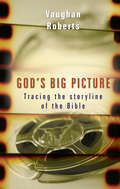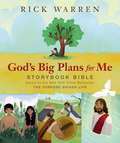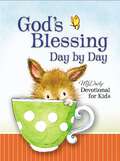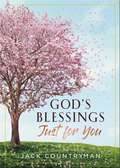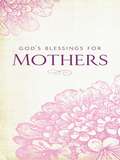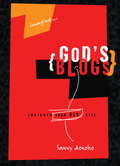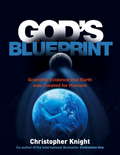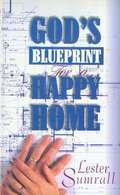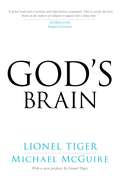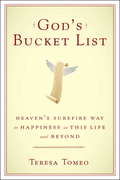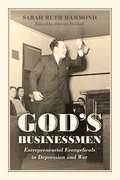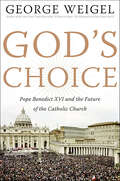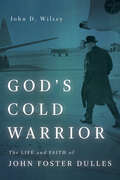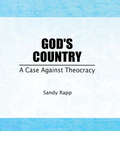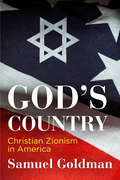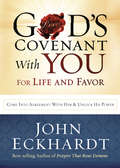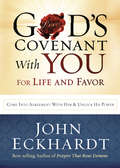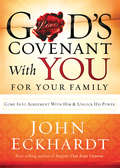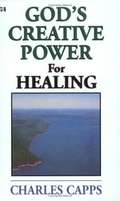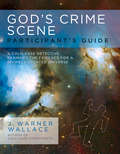- Table View
- List View
God's Big Picture Bible Storybook: 140 Connecting Bible Stories of God’s Faithful Promises
by N. T. WrightThis first illustrated Bible storybook from one of the world's top Bible scholars draws the connections across all of God's very good story, His Word. This practical Bible guide shares all your family's favorite stories, plus some that may be new, combining a theologian's expertise with engaging narratives that will draw kids into the good news of the world's greatest, truest tale.God's Big Picture Bible Storybookis for children ages 6 to 10;is the first children's book written by scholar and professor Tom (N.T.) Wright;identifies story parallels across the Bible that show kids that all of God's Word matters;includes 140 short stories, each vividly illustrated by award-winning artist Helena Perez Garcia; andshows the intention behind God's stories and the hope for salvation they provide.N.T. Wright wants his readers to discover the many surprising ways in which one Bible story echoes another, and how different stories contribute to the one very good and very big story of God's love for creation--a story that unfolds over the centuries, until at last it is fully revealed in the life and teaching of Jesus. Young readers will be fascinated and delighted as they hear the echoes and spot the visual links between the pictures and the stories. Not only that, they will be thrilled to discover that this is not just a story involving people who lived long ago: it's a living and enduring story, a story in which God invites them to be involved as well!
God's Big Picture: Tracing the Storyline of the Bible
by Vaughan RobertsSixty-six books written by forty people over nearly 2,000 years, in two languages and several different genres. A worldwide bestseller published in countless sizes and bindings, translations and languages. Sworn by in court, fought over by religious people, quoted in arguments. The Bible is clearly no ordinary book. How can you begin to read and understand it as a whole? In this excellent overview, Vaughan Roberts gives you the big picture—showing how the different parts of the Bible fit together under the theme of the kingdom of God. He provides both the encouragement and the tools to help you read the Bible with confidence and understanding. And he points you to the Bible's supreme subject, Jesus Christ, and the salvation God offers through him.
God's Big Plans for Me Storybook Bible: Based on the New York Times Bestseller The Purpose Driven Life
by Rick WarrenGod’s Big Plans for Me Storybook Bible illustrates the 40 foundational principles written in the #1 New York Times bestseller The Purpose Driven Life (What on Earth Am I Here For?) by Pastor Rick Warren. With child-friendly language, engaging illustrations, and a chronological approach, Pastor Warren introduces each Bible story with a theme that aligns with one of his foundational principles. He wraps up the stories with a closing thought targeted to early readers. The colorful illustrations and narrative tone bring these beloved Bible stories to life for readers young and old.
God's Big Plans for Me Storybook Bible: Based on the New York Times Bestseller The Purpose Driven Life
by Rick WarrenThe God&’s Big Plans for Me Storybook Bible uses kid-sized versions of the 40 foundational principles found in the #1 New York Times bestseller The Purpose Driven Life by pastor Rick Warren, helping boys and girls find the same motivating love of Christ in their own lives. Pastor Warren&’s unique approach starts by introducing each Bible story with a theme that aligns with one of his renowned PDL principles. Then, he uses colorful illustrations and an engaging, narrative tone to guide younger readers through each story. Finally, he wraps up the stories with a closing thought that turns each principle into a practical step boys and girls can take to discover God&’s big plans for them. Warren is a natural storyteller, and his principles have changed the lives of millions of adults. The God&’s Big Plans for Me Storybook Bible is the kid-friendly version that parents, grandparents, pastors, and teachers have been waiting for. God&’s Big Plans for Me Storybook Bible: Uses child-friendly language to introduce and engage children ages 4-8 in 40 of the most important Bible storiesIncludes illustrations that visually highlight—at a child&’s comprehension level—the 40 foundational principles from the New York Times bestseller, The Purpose Driven LifeFeatures an easy-to-understand, chronological approach to Bible reading
God's Blessing Day By Day: MyDaily Devotional for Kids
by Johnny HuntGod&’s Blessing Day by Day is a trustworthy devotional compiled by renowned pastors and church leaders. Edited by Johnny Hunt, former president of the Southern Baptist Convention, this devotional is the perfect way to introduce your children and grandchildren to a legacy of faith.One of the greatest gifts - and greatest challenges - of raising children is introducing them to the ways of God. As parents and grandparents, we want to impart our faith to the children we love so dearly, and it can feel more difficult than ever in the fast-moving, instant-access culture in which we find ourselves.God&’s Blessing Day by Day,compiled by Johnny Hunt and more than 50 pastors and church leaders, is the perfect way to build faith through gratitude.This easy-to-understand, child-friendly devotional is the perfect way to engage your family. Each devotion is written on topics children care about and includes great prayers and takeaways that will spark conversation as the timeless Word of God instructs and inspires your children.Impart a deeper connection with the Lord in your children, help them establish healthy habits of devotion and prayer, and equip them with the tools they need to grow their faith.
God's Blessings Just for You: 100 Devotions
by Jack CountrymanGod wants to bless you. In fact, He showers you with blessings when you walk in obedience with Him. In this powerful book Jack Countryman shares 100 scripture blessings from the Bible, along with thoughtful reflections, to remind us of the many ways God shows his love for us.Each chapter in God&’s Blessings Just for You leads you into a deeper relationship with God, making this simple but effective book a wonderful addition to your daily devotions. This is a beautiful reminder of God&’s presence for friends and loved ones going through difficult times as well as:graduationsbirthdaysChristmasMother&’s and Father&’s DayThis book from Jack Countryman, who has sold more than 20 million books, takes you on a biblical journey to discover the many ways God wants to bless you today and always.
God's Blessings for Mothers
by Jack CountrymanSpecial blessings for a special mother.Motherhood is filled with wonderful moments and memorable adventures. But when those adventures become challenging, mothers need encouraging words straight from the Father. In God's Blessings for Mothers, scriptures from the New King James Version® offer mothers loving wisdom on such topics as grace, peace, patience, and contentment--perfect inspiration for all the joys and challenges of motherhood.
God's Blogs: Life from God's Perspective
by Lanny DonohoHow would you feel if you thought God wrote a personal note to you...on His website...and it was about some of the stuff that makes you wonder if He really exists at all? This book does make you feel...while it makes you think. Maybe God isn't who we thought He was. Maybe His thoughts aren't what we have been taught. God's Blogscontains some insightful, fresh thoughts that help us see more of God's character, His love, and His grace as He reflects on marriage, death, laughter, dads, and questions like "Why are we here?" and, "What about tsunamis and poverty?" A fascinating read that will make you laugh and cry and search your own thoughts about who He is. What Might God Say on His Blogsite? Basically I'm entering into your blogdom becausesomehow the rumor got started that I was kind of boring. For those of you who bought into that craziness, you should know that I'm the one who created all the stuff you love...all the stuff that makes life exciting. I invented funny and laughter. I created adventure and romance... I laugh a lot.
God's Blueprint
by Christopher KnightGod's Blueprint is the boldest statement yet by the popular expositor of "sacred geometry," Christopher Knight. While decidedly not in the camp of Evangelical Christians, Knight makes the case for Intelligent Design using astronomical data. Most scientists reject the notion of God because they require factual, checkable evidence in order to accept any proposition as being real. But now new evidence has became available that provides hard-nosed evidence of God's existence. Nothing less than God's blueprint appears to have been discovered - found accidentally by the author while researching the science of the Neolithic (late Stone Age) people of Western Europe. Presented in the form of an evidentiary hearing, Knight makes his case in a step-by-step manner, making you the jury. At the close of the book you are asked to make a judgment as to whether the case is proven or not. The evidence will be sure to surprise and delight you. The only question that remains is, will scientists embrace the concept of a Supreme Being, as they once did in Isaac Newton's day?
God's Blueprint for a Happy Home
by Lester SumrallWhat are the foundations and building blocks of a successful family? What does the blueprint from God look like? In this book, missionary statesman Lester Sumrall draws on decades of experience in raising a Christian family to show parents and children everywhere just what God intended for a healthy family. Marriage, trust, communication, and the gift of children are just a few of the topics covered in this blueprint for God, as given over the years to one of his most dedicated servants. Building a solid marriage and nurturing our precious children should be the top priority today. For some it is a priority - others are searching. This book is for the searchers.
God's Brain
by Lionel Tiger Michael McGuireIn the fractious debate on the existence of God and the nature of religion, two distinguished authors radically alter the discussion. Taking a perspective rooted in evolutionary biology with a focus on brain science, the authors elucidate the perennial questions about religion: What is its purpose? How did it arise? What is its source? Why does every known culture have some form of it? Their answer is deceptively simple, yet at the same time highly complex: The brain creates religion and its varied concepts of God, and then in turn feeds on its creation to satisfy innate neurological and associated social needs. Brain science reveals that humans and other primates alike are afflicted by unavoidable sources of stress that the authors describe as "brainpain." To cope with this affliction people seek to "brainsoothe." We humans use religion and its social structures to induce brainsoothing as a relief for innate anxiety. How we do this is the subject of this groundbreaking book. In a concise, lively, accessible, and witty style, the authors combine zoom-lens vignettes of religious practices with discussions of the latest research on religion’s neurological effects on the brain. Among other topics, they consider religion’s role in providing positive socialization, its seeming obsession with regulating sex, creating an afterlife, how religion’s rules of behavior influence the law, the common biological scaffolding between nonhuman primates and humans and how this affects religion, a detailed look at brain chemistry and how it changes as a result of stress, and evidence that the palliative effects of religion on brain chemistry is not matched by nonreligious remedies. Concluding with a checklist offering readers a means to compute their own "brainsoothe score," this fascinating book provides key insights into the complexities of our brain and the role of religion, perhaps its most remarkable creation.
God's Bucket List
by Teresa TomeoFrom the popular EWTN TV and radio personality comes a to-do list that's just divine.Scripture tells us only God knows the desires of our hearts. It was, after all, God who placed them there because they are designed to lead us to His will for our lives. Why, then, is it so challenging at times to figure out if we are on the right track when it comes to what we believe we want or need? God's Bucket List will examine what God wants for each of us: mercy, fruitfulness, fellowship, and peace, just to name a few, and will explain what the Christian faith teaches about these gifts and how we can begin to achieve and cross out, one by one, the items on that heavenly list.
God's Business: How to Supercharge Your Faith, Your Profit, and Your Client Experience (Morgan James Faith)
by Frederick "Coach" West IIIThe conflict between staying true to your faith and staying true to your company is a constant battle for Christian business owners. The serenity you feel on Sunday soon goes away Monday morning when dealing with customers, vendors, and employees. So here’s the question: Can you have God in your life every day so that you can feel that joy constantly? YES! In God’s Business: How to Supercharge Your Faith, Your Profit, and Your Client Experience, Frederick “Coach” West III lays the foundation to enjoy more of your faith in your business.
God's Businessmen: Entrepreneurial Evangelicals in Depression and War
by Darren Dochuk Sarah Ruth HammondThe evangelical embrace of conservatism is a familiar feature of the contemporary political landscape. What’s less well-known, however, is that the connection predates the Reagan revolution, going all the way back to the Depression and World War II. Evangelical businessmen at the time were quite active in opposing the New Deal—on both theological and economic grounds—and in doing so claimed a place alongside other conservatives in the public sphere. Like previous generations of devout laymen, they self-consciously merged their religious and business lives, financing and organizing evangelical causes with the kind of visionary pragmatism that they practiced in the boardroom. In God’s Businessmen, Sarah Ruth Hammond explores not only these men’s personal trajectories but also those of the service clubs and other institutions that, like them, believed that businessmen were God’s instrument for the Christianization of the world. Hammond presents a capacious portrait of the relationship between the evangelical business community and the New Deal—and in doing so makes important contributions to American religious history, business history, and the history of the American state.
God's Challenge for Dads: A 90-Day Devotional Experiencing God's Truths
by Eric BallardHave you gotten comfortable—maybe even complacent—in your spiritual life? Maybe you can check off all the right boxes—going to church, reading your Bible, praying before meals. Maybe you even lead a small group or serve as a deacon and tithe regularly. But when was the last time someone really shook up your faith, really challenged you to get after it, to pursue God with your whole heart? In this devotional written specifically for dads, Eric Ballard draws wisdom from the men written about in the Bible to push you out of your comfort zone and into a more authentic, whole-hearted relationship with God, which will lead to more meaningful relationships with your family, coworkers, and community. Each devotional includes a scripture, insight into the context and purpose of the passage, a brief prayer, and a challenge. Sometimes the challenges are external—simple ways to let your wife know you think she’s amazing or to make your children feel cared for. Sometimes they’re internal—like daring to let go of your own self-sufficiency and acknowledge you can’t do anything right without the Holy Spirit working through you. Allow yourself to be pushed, stretched, and molded into the dad God has called you to be. Discover the Bible’s wisdom on everything from work struggles to parenting difficult kids to loving your wife well. Take an honest look at the idols you need to lay down, now. Look a little closer at how you think and talk about work. Discover what godly parenting really means. Are you ready to accept God’s challenge? Your kids will be grown before you know it. Don't wait another minute to become the dad God wants you to be.
God's Choice: Pope Benedict XVI and the Future of the Catholic Church
by George WeigelWeigel introduces us to Pope Benedict XVI. What was this man thinking when he knew that he might be elected? How did the process work? What is the historical significance for the Catholic Church? What is John Paul II's legacy? Although rich with detail, this book is a lucid and fascinating consideration of the monumental events of 2005.
God's Choice: Pope Benedict XVI and the Future of the Catholic Church
by George WeigelGeorge Weigel's New York Times bestselling biography of Pope John Paul II, Witness to Hope, set the standard by which all portraits of the modern papacy are now measured. With God's Choice, he gives us an extraordinary chronicle of the rise of Pope Benedict XVI as well as an unflinching view of the Catholic Church at the dawn of a new era.When John Paul II lapsed into illness for the last time, people flocked from all over the world to pray outside his apartment. He had become a father figure to millions in a world bereft of strong paternal examples, and those millions now felt orphaned. After more than twenty-six years of John Paul II's guidance, the Catholic Church is entering a new age, with its bedrock traditions intact but with pressing questions to address in a rapidly changing world. Beginning with the story of John Paul's final months, God's Choice offers a remarkable inside account of the conclave that produced Benedict XVI as the next pope, drawing on George Weigel's unrivaled access to this complex event.Weigel also incisively surveys the current state of the Church around the world: its thriving populations in Africa, Latin America, and parts of the post-communist world; its collapse in western Europe; its continued struggles in Asia; and the vibrancy of many aspects of Catholic life in the United States, even as the Church in America struggles to overcome its recent experience of scandal.Reflecting on John Paul II's greatness, drawing on firsthand interviews to paint an intimate portrait of the new Pope, and boldly assessing the Church's current condition, God's Choice is an invaluable book for anyone seeking to understand the Catholic future and the larger human future the Church will help to shape.
God's Cold Warrior: The Life and Faith of John Foster Dulles (Library of Religious Biography (LRB))
by John D. WilseyWhen John Foster Dulles died in 1959, he was given the largest American state funeral since Franklin Delano Roosevelt&’s in 1945. President Eisenhower called Dulles—his longtime secretary of state—&“one of the truly great men of our time,&” and a few years later the new commercial airport outside Washington, DC, was christened the Dulles International Airport in his honor. His star has fallen significantly since that time, but his influence remains indelible—most especially regarding his role in bringing the worldview of American exceptionalism to the forefront of US foreign policy during the Cold War era, a worldview that has long outlived him. God&’s Cold Warrior recounts how Dulles&’s faith commitments from his Presbyterian upbringing found fertile soil in the anti-communist crusades of the mid-twentieth century. After attending the Oxford Ecumenical Church Conference in 1937, he wrote about his realization that &“the spirit of Christianity, of which I learned as a boy, was really that of which the world now stood in very great need, not merely to save souls, but to solve the practical problems of international affairs.&” Dulles believed that America was chosen by God to defend the freedom of all those vulnerable to the godless tyranny of communism, and he carried out this religious vision in every aspect of his diplomatic and political work. He was conspicuous among those US officials in the twentieth century that prominently combined their religious convictions and public service, making his life and faith key to understanding the interconnectedness of God and country in US foreign affairs.
God's Country: A Case Against Theocracy
by Sandy RappExplore the influence of religion on the privacy rights of U. S. citizens in this controversial new book!Here is a compelling and controversial new book that explores the enormous political influence that some religious groups currently wield. God’s Country focuses particularly on the issue of personal privacy rights and the strategies and rhetoric these religious groups are using to diminish those rights among select segments of society. Author Sandy Rapp, a grassroots activist, shares her experiences in one-on-one debates with religious fundamentalists who have been on opposite sides of the social issues for which she has so passionately fought in recent years. Topics in this fascinating book include: privacy rights individual’s rights as stated in the constitution AIDS and homophobia the abortion choice global population crisis gay and lesbian reporductive rights effective strategies for lobbyingSandy Rapp traces the patriarchal premises which underlie the twentieth-century crusade against homosexuality. She integrates various personal and professional perspectives and provides a challenging and comprehensive examination of the physical and psychological devastation inflicted upon women, lesbians, and gay men due to religious and political control over such personal decisions as the expression of one’s sexuality, the use of birth control, the choice of abortion, and privacy rights. God’s Country poses some provocative questions that are certain to spark debate among enlightened religious professionals, professors, and students of political science, government, women’s history, human sexuality, and religion: Does the government have the right to impose mandatory childbirth upon women? Should a gay or lesbian person’s sexual orientation weaken his/her civil rights? Can, in a free society, the religious beliefs of one denomination or group be imposed on all citizens? If freedom for all is to upheld in the United States, shouldn’t the separation of church and state be maintained?
God's Country: Christian Zionism in America (Haney Foundation Series)
by Samuel GoldmanThe United States is Israel's closest ally in the world. The fact is undeniable, and undeniably controversial, not least because it so often inspires conspiracy theorizing among those who refuse to believe that the special relationship serves America's strategic interests or places the United States on the right side of Israel's enduring conflict with the Palestinians. Some point to the nefarious influence of a powerful "Israel lobby" within the halls of Congress. Others detect the hand of evangelical Protestants who fervently support Israel for their own theological reasons. The underlying assumption of all such accounts is that America's support for Israel must flow from a mixture of collusion, manipulation, and ideologically driven foolishness.Samuel Goldman proposes another explanation. The political culture of the United States, he argues, has been marked from the very beginning by a Christian theology that views the American nation as deeply implicated in the historical fate of biblical Israel. God's Country is the first book to tell the complete story of Christian Zionism in American political and religious thought from the Puritans to 9/11. It identifies three sources of American Christian support for a Jewish state: covenant, or the idea of an ongoing relationship between God and the Jewish people; prophecy, or biblical predictions of return to The Promised Land; and cultural affinity, based on shared values and similar institutions. Combining original research with insights from the work of historians of American religion, Goldman crafts a provocative narrative that chronicles Americans' attachment to the State of Israel.
God's Covenant With You for Deliverance and Freedom: Come Into Agreement With Him and Unlock His Power
by John EckhardtDiscover God’s Everlasting Covenant of Peace and Protection Covenant is the foundation of all of God’s interactions with us. In fact, success for every part of your life is dependent on how you respond to God’s promises and divine plans for you. God’s Covenant With You for Deliverance and Freedom demonstrates God’s covenant promises of safety, protection, peace, and prosperity, covering: · Today’s most prevalent strongholds and demonic influences · How to overcome personal struggles and end cycles of “bad luck” · Ways to overcome strongholds and live victoriously though all of life’s storms Deliverance out of trouble is God’s mercy extended to those who are in covenant with Him. When we stay true to our covenant with God, we can be sure that no matter what happens in life, it is God’s everlasting promises of peace that will sustain us and bring us through victoriously.
God's Covenant With You for Life and Favor: Come Into Agreement with Him and Unlock His Power
by John EckhardtGOD HAS ALREADY MARKED A PATH OF SUCCESS FOR YOU Covenant is enacted in every part of your life from marriage andfamily to deliverance and freedom all the way down to yourfinances. When you stay true to your covenant with God, you can besure that no matter what storms come in life, it is God's everlastingcovenant of peace that will bring you through victoriously. God &’s CovenantWith You for Life and Favor shows you how being in covenant with God:Frees you from your pastAllows you to harness your future with expectancyPuts you in position to receive the supernatural wisdom of GodCatapults you into the new things of God, and much more!When you stay true to your covenant with God, you can be sure that for every circumstance you face, it is His everlasting covenant that will bring you through to victory.
God's Covenant With You for Your Family: Come into Agreement With Him and Unlock His Power
by John EckhardtFrom the Old Testament to the New, God has never consistently blessed a people without first having a covenant with them.John Eckhardt&’s previous series on prayer has sold over half a million copies. In this new series that follows the same dynamic format, he shares his teaching on covenant and the blessings that accompany it.Covenant is the foundation of everything that we are as believers. Based on the covenant blessings listed in Leviticus 26:3–12 and Deuteronomy 28:1–14, John Eckhardt&’s covenant series outlines how covenant is enacted in every part of our lives from marriage and family to deliverance and freedom all the way to our finances. God&’s Covenant With You for Your Family covers:· Explanations on what covenant means in the Old and New Testaments· What God says about you and your household· Maintaining your covenant with God and breaking generational cursesWhen we stay true to our covenant with God, we can be sure that no matter what storms come in life, it is God's everlasting covenant of peace that will bring us through victoriously and sustain us.
God's Creative Power for Healing: Minibook
by Charles Capps"This powerful book combines all new teaching with Scripture confessions for healing. You will learn how you can release the ability of God for your healing by the words of your mouth!" Even though the author wants people to rely on God for healing, he also encourages them to seek the help of medical doctors to augment the Christian faith practices that Capps discusses in this book.
God's Crime Scene Participant's Guide: A Cold-Case Detective Examines the Evidence for a Divinely Created Universe
by J. Warner WallaceCustom illustrated by the author, renowned cold-case detective, author, and speaker J. Warner Wallace, this exclusive participant’s guide engages the audience in the “investigation” into whether the universe as we see it just happened, or if there is evidence of a divine “intruder”—or rather, God. Companion to the eight-part video series, participants will dive into one of the most meaningful and challenging questions: Does God exist? This highly visual guide helps the participant engage with the content to ultimately develop an investigative skill set similar to what a detective might use in investigating a homicide.
